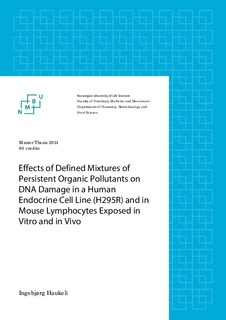| dc.description.abstract | A wide range of synthetic chemicals have been used extensively for decades. They are ubiquitous in the environment, and can therefore pose adverse effects on humans and wildlife. Mixtures of persistent organic pollutants (POPs) that are relevant to real –life exposure, are of emerging concern when it comes to their potentially adverse effects and the ability to interact with other substances.
The main objective of this study was to investigate exposure –relevant mixture of POPs, based on levels recently measured in blood and breast milk in Scandinavia, for the in vitro study. The in vivo study based the mixture on estimated daily intake measured in food. DNA damage was assessed by the method of choice; comet assay and used on the human adrenocortical carcinoma cell line –H295R and isolated lymphocytes from mice.
The effect of a mixture containing brominated, chlorinated and perfluorinated compounds (total mixture), and sub –mixtures containing respectively, brominated, chlorinated and perfluorinated compounds, were used on the cytotoxic potential, characterized by means of Alamar Blue® viability assay. The total mixture and the sub - mixtures were used to assess the percent of DNA damage in the adrenal cell line –H295R. Isolated lymphocytes from mice were used to assess the percent of DNA damage, both in vitro and in vivo, using the total mixture.
The in vitro exposure of the mice lymphocytes revealed a small, but significant increase in the percent of DNA damage lymphocytes for the exposure dose 10-8 when compared to the solvent control, and there were an indication that each mouse reacted differently to exposure and exposure dose. Furthermore, the in vivo exposure on mice lymphocytes did not show any significant change in DNA damage when compared to the unexposed control group, but the high group and the low group were significantly different from each other.
The in vitro exposure of the H295R cells gave a significant dose –response relationship for the perfluorinated sub –mixture and the total mix. Furthermore, exposure to the mixtures did not reveal any significant differences at the concentrations corresponding to the approximate levels of relevant POPs measured in human blood and breast milk. However, the highest dilution of the perfluorinated sub –mixture was cytotoxic to the H295R cells. The perfluorinated sub –mixture caused an abrupt decline in viability, at the highest dilution (10-3), while the other mixtures were stable at about >95 %. | nb_NO |

